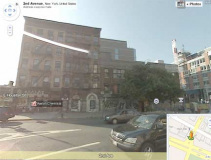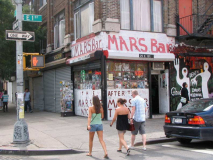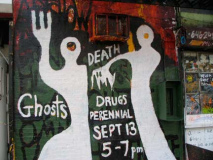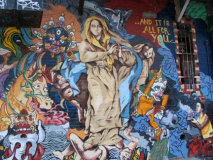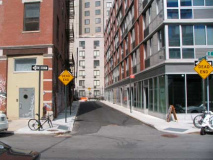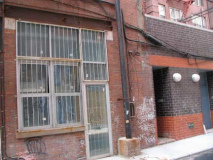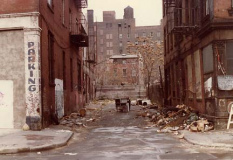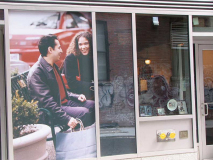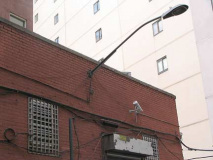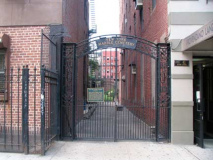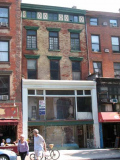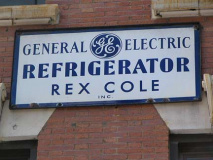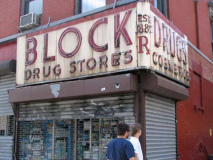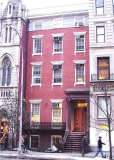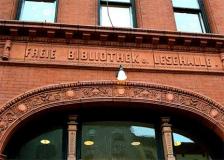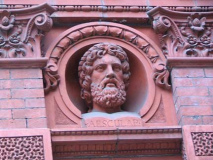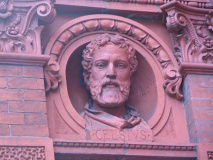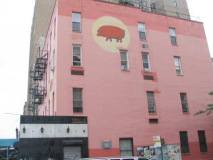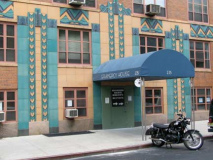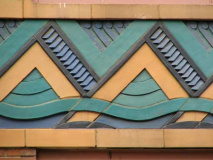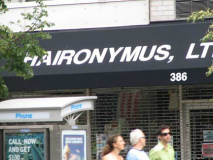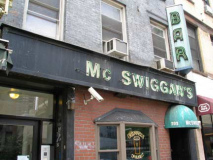Over the course of six years I wound up taking two different batches of photos on 2nd Avenue between Houston Street and 34th. Like the Bowery, which it (sort of) parallels for a few blocks, it is now the theater for a new round of gentrification that promises to erase some of its unique quality. Lower Second Avenue has been German (the Kleindeutschland devastated by the General Slocum accident in 1904) Jewish (the Second Avenue Deli its most noted manifestation), Indian, Polish, and even the Irish had a now-little known enclave. Now that some of lower 2nd is due to follow much of the Bowery under the wreckers’ ball, I thought it would be a good time to revisit the disparate shots and stitch them into a page that will reveal what is due to disappear, and what will still be available for viewing. 1st and 2nd Avenues are the only two of Manhattan’s numbered avenues that run in a straight line from Houston Street north to the Harlem River (separated from the river in the 1940s by the East River (FDR) Drive.
Lower Second will lose some if its old soul if the row of buildings on its west side between Houston and East 1st is demolished, as Curbed reported in December 2010, as part of BFC Partners’ plan to erect glass-fronted residential buildings comes to fruition. There have been other rumors that BFC was going to merely renovate the buildings, but recent developments indicate that #9-17 2nd Avenue (which appear on the right side of the photo) will be torn down completely.
The building on the left, 9 2nd Avenue, now home to a Taoist temple and a kung fu martial arts training facility, was built in the late 1800s as a part of a complex built by German immigrants known as Germania Hall, which ran through to the Bowery one block west. The complex also included a norotious brothel known as McGurk’s Suicide Hall (see my Bowery page) so named because prosititutes would commit suicide there by poisoning themselves. The building was then home to The Church of All Nations, a Methodist settlement house founded in 1922, and then a Puerto Rican cultural group (some say gang) called CUANDO.
Life in Mars
Slated for demolition, or at least displacement for 2 years or more, is Mars Bar on the SW corner of 2nd Avenue and East 1st Street, which has been called the quintessential New York dive bar by more than one observer. The handwritten sign obscured by the pedestrian reads “After the Mars Bar, then what?” More blandification, I’d say.
Writing in the original (2003) edition of New York’s Best Dive Bars, Wendy Mitchell writes:
Despite the friendly crowd, the Mars Bar more than lives up to its reputation as New York’s King (and Queen and Prince) of dives. If you’re up for adventure, you might find it here, wrapped in many layers of filth. The place is dank, dark and dirty, and the night I was there I saw the largest cockroach I have ever seen in New York City, In addition, the bathroom will put fear in the hearts of mere mortals. It also worried me a bit that the obviously intoxicated bartender (obvious because she was drinking shots) was mixing drinks with orange juice sitting out behind the bar like you’d see at some frat party…
The crowning touch, however, are the cases of beer stacked up in the back like the Great Wall of China, plus dozens upon dozens of empties strewn about the rest of the bar. If all of this isn’t enough to leave your head spinning with wonder at what the seedy years of pre-Giuliani NYC were like, you’re assured of at least a bit of a time warp thanks to an old alarm clock that always reads “Wed Jan 23.”
Mars Bar is covered, inside and out, with amateur and “outsider” art. In New York Nearsay, Vivienne Gucwa tales a look at the interior and perhaps, offers an elegy:
When Mars Bar first came into existence, New York City was trying desperately to rebound from the economic crisis of the 1970s. The East Village community was comprised of those trying to build the community up along with those who were settling into the neighborhood hoping to experience the East Village’s thriving artistic community. The East Village had a distinct reputation for embracing those with anarchist ideas and a bohemian flair. The East Village was a place where anything could happen, a haven for the arts in all forms. Mars Bar was simply the sum of all of these complex pieces of a blossoming equation.
A Little Something Extra
There was something of a surprise in May 2011 when high-end chocolatier, Bespoke Chocolates, ended the business after a couple of years on Extra Place, the dead end running north from East 1st between the Bowery and 2nd Avenue. Extra Place was extra land left over when in 1800, landowner Philip Minthorne divided his 110-acre farm equally among his four sons and five daughters. A tiny parcel was left over, which became Extra Place. I’ve always been fascinated with it, since I when I first found it on my way to a Certain General show at CBGB in December 1981, it looked the way it did when NYC lamppost king Bob Mulero snapped it in 1978 (right).
When Avalon Bay began building high rise buildings for rich Manhattanites in the newly chic East Village in the mid-2000s, it also gave Extra Place a complete makeover, especially to the alley’s east side, which it controlled, but it also paved the old alley for the first time since it boasted paving stones, and even installed sidewalks. I think Avalon hoped to give Extra Place some of the buzz another anicent alley. Freeman’s, acquired when its eponymous restaurant opened there, but so far, the buzz has gone flat. Some of the ancient Extra Place can still be glimpsed.
The reflection of the old west side of Extra Place can be seen in the Avalon ad showing the shiny happy young clientele it hopes to attract. Meanwhile, a wall lamp that has been there since the Ramones and thousands of other bands were exiting out the back of CBGB is still there, with a shattered luminaire, while the end is still near at the rear.
The New York Marble Cemetery, visible through a locked gate on the west side of 2nd Avenue adjoining the serendipitously located Provenzano Funeral Home, is located mid-block, facing the back spaces of adjoining buildings on East 2nd East 3rd Streets and 2nd Avenue, but not the avenue itself. The cemetery is unusual in that it has no headstones, just burial vaults. It is sometimes open to the public during Open House NY, the first weekend in October.
The cemetery opened in 1831 as the first nonsectarian cemetery in NYC. Its vaults filled so quickly that a separate cemetery, New York City Marble Cemetery, opened nearby, facing East 2nd east of 2nd Avenue. Michigan Governor Steven Thomas Mason, the first governor of the state from 1835-1840, is interred here, as well as 1837-1839 NYC Mayor Thomas Clark and congressman (1817-1819) James Tallmadge.
The rather spare 1968 Roman Catholic Church of the Nativity (right) stands at 46-48 2nd Avenue, opposite the cemetery, replacing an earlier Greek temple styled, Ionic-columned building constructed in 1831 as a Presbyterian church, but sold to the Catholic parish in 1842. The original church was demolished just before the new one was constructed.
Brick buildings along this stretch of 2nd Avenue can be as old as the 1830s. The one at left has an unusual diamond treatnent just under the eaves, and a glass front of later design, though likely also several decades old. Allied Hardware has a vinyl-lettered 1960s-era sign, with PAINTS spelled with each letter a different color. Both can be found on 2nd Avenue between East 3rd and East 5th.
I found a pair of Rex Cole Refrigerator signs on this building on the NW corner of 2nd Avenue and East 5th. Cole (1887-1967) was originally a lamp manufacturer, then became associated with General Electric in the 1920s and designed white enamel Monitor Top refrigerators. Famed architect Raymond Hood designed a series of buildings in Bay Ridge, Brooklyn, the Grand Concourse, and Northern Blvd. in Flushing for Cole’s showrooms that either looked like refrigerators or featured them in the design! Most are still standing but have been altered beyond recognition. Enamel signs proclaiming Cole’s GE refrigerators can still be found on a handful of buildings around town.
The amazing Block Drugs red neon sign on the SW corner of 2nd Avenue and East 6th, which must go back to the fab Forties, still lights up brilliantly at night. As nostalgia has taken hold in bistroville, with many sins of former businesses being reto-fitted for use in modern ones (as in Prime Meats, a new German restaurant in Brooklyn which employs a glass-etched sign found (I think) on Flatbush Avenue) I wish there would be a retro-neon trend, with new neon signs being made in the classic fashion.
Block has been in business since 1885, as the corner of the sign indicates.
Only neighborhood old timers and sharp-eyed walkers who see East Village Mosaic King Jim Power’s stoplight decorations know that the narrow brick building on 2nd Avenue just north of East 6th, now home to an Emigrant Bank on the ground floor, was once one of NYC’s capitals of rock and roll, the Fillmore East (right). Graham took over the old cinema/Yiddish theatre in early 1968 and for two full years and part of two others presented a roster of superstars that to this day reads like a classic rock radio playlist. Just about every big name in rock and roll except the Beatles and Stones played the Fillmore East (Graham’s east coast counterpart was the Fillmore West in San Francisco.) See FNY’s Fillmore Slice.
The Tiffany windowed, double-spired Middle Collegiate Church has stood on 2nd Avenue between 6th and 7th Streets since 1892. Just next door is 110 2nd, the Isaac T. Hopper House, built in 1839, which early on in its history was a “home for wayward girls” instituted by Hopper, an abolitionist Quaker. It is the lone survivor of a set of four such Greek Revival townhouses. 110 2nd is the headquarters of the Women’s Prison Association, which assists women who have been in the criminal justice system.
Two deep-red brick buildings on the west side of 2nd north of St. Mark’s Place appear as if they were built at the same time and by the same architect and indeed both were designed by William Schickel and completed in 1884. The Freie Bibliothek und Lesehalle (Free Library and Reading Room) and next door, the Stuyvesant Polyclinic, are both remnants of Kleindeutschland, the primarily German population that lived in the area in the late 1800s to early 1900s. The General Slocum disaster and America’s entry into World War I served to dissolve the clinic’s early German association, however, but the German inscription can still be seeen over the library, now the Ottendorfer Branch of the NYPL. The facade of the clinic is festooned with busts depicting both real and mythological physicians and scientists of the classic Greek and Roman eras (such as Aesculapius), and also from the Europe of the 1880s (Anders Celsius).
St. Mark’s In The Bowery, at 2nd Avenue and East 10th, is the oldest building on 2nd Avenue, dating to 1799, with additions in 1828 (the steeple) and 1858. Most of the church had to be rebuilt after a devastating fire in 1978. It stands on the chapel site of Peter Stuyvesant’s 17th Century estate (the Director-General is interred in a vaultin the churchyard, as his great-grandson sold the property to the Episcopal Church in 1793) and is turned to face Stuyvesant Street, once the driveway to the estate. St. Mark’s claims to be the oldest site of continuous worship in NYC. St. Marks’ rectory is a force in neighborhood preservation and is an enthusiastic patron for the arts. NYC mayor and diarist Philip Hone and NYS Governor and US Vice President Daniel D. Tompkins are also interred in the churchyard.
Two identical pink pigs adorn the building on the NE corner of 2nd Avenue and East 12th Street. They first showed up in late 1999 when the building was repainted, and were commissioned by building owner Jerry Atkins. They were apparently inspired by a slogan of Fink’s Work Clothes, a brand popular in the 1920s and 1930s: ”Fink’s Work Clothes, Hard as a Pig’s Nose.” The pigs appeared on clocks distributed by the company. Atkins had used the pig imagery at various of his businesses around town.
I rushed past Stuyvesant Square, surrounding 2nd Avenue between East 15th and 17th Streets (it will be discussed in a FNY series on Manhattan’s public squares) , and the Eye and Ear Infirmary and the “US Senate Building” on East 14th and 2nd. This is the wildly Art Deco Gramercy House on 2nd and East 22nd Streets. The building is under consideration for landmarking (in mid-2011).
The hair salon called Haironymus, Ltd. likely takes its name from the mysterious Renaissance-era Dutch painter, Hieronymus (Jerome) Bosch (1450-1516), who used fantastical and surreal images to depict morality and the lack of it. His most famous work is probably The Garden of Earthly Delights, which presents his vision of Adam and Eve on earth; a possibly immoral earth; and hell, full of monstrous demons doing unspeakable things; in many regards, in his bizarre imagery, he portends Surrealism by over four centuries, and Salvador Dali no doubt was influenced by him.
Right: McSwiggan’s has since replaced the neon Helvetica awning sign.
Let not your heart be troubled, the Clover Deli at East 34th is still open, but it was closed the Sunday I went past.
2020 update: Let your heart be troubled. The Clover closed late this year.
5/15/11


